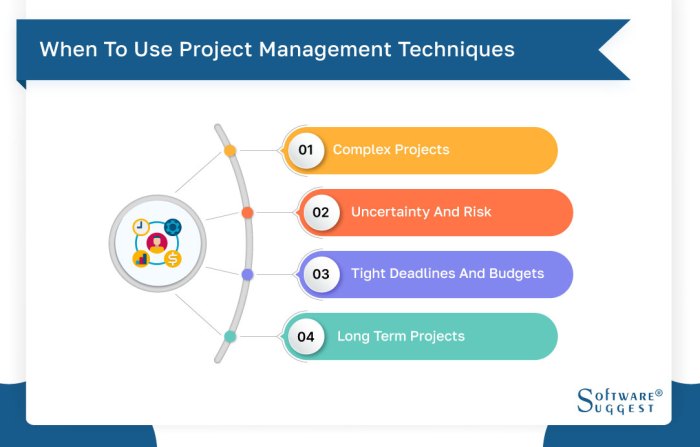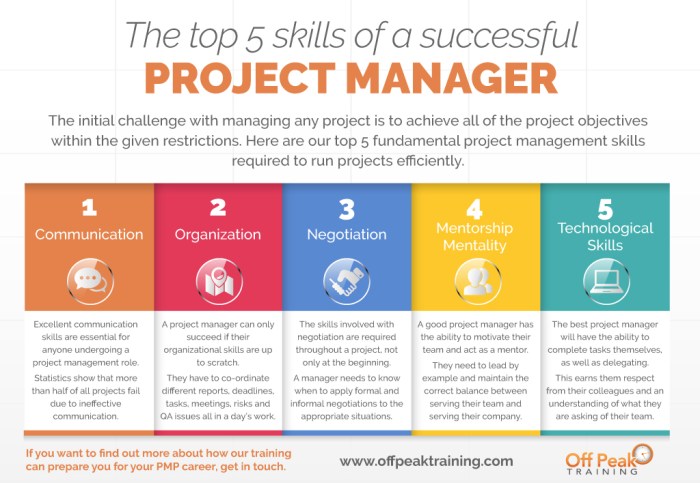Project Management Techniques takes center stage, ushering readers into a world of knowledge and expertise. Get ready to dive into the realm of project success with a blend of traditional, agile, and lean techniques.
Learn how these strategies can elevate your projects to new heights and uncover the secrets behind effective project management.
Overview of Project Management Techniques
Project management techniques are tools, skills, and processes used to effectively plan, execute, and monitor projects from start to finish. These techniques help project managers and teams stay organized, meet deadlines, manage resources efficiently, and deliver successful outcomes.
Popular Project Management Techniques
- Agile: A flexible approach that focuses on iterative development, collaboration, and responding to change quickly.
- Waterfall: A sequential method where each phase of the project is completed before moving on to the next.
- Scrum: An Agile framework that emphasizes teamwork, accountability, and the ability to respond to emerging requirements.
- Kanban: A visual system for managing work as it moves through a process, helping teams optimize workflow and identify bottlenecks.
Traditional Project Management Techniques
In traditional project management, the focus is on thorough planning and following a sequential process to complete a project. This approach is often referred to as the waterfall method.
The Waterfall Method
The waterfall method is a linear approach to project management where each phase must be completed before moving on to the next. The key characteristics of the waterfall method include:
- Sequential flow of tasks
- Emphasis on planning and documentation
- Rigid structure with little room for changes
- Clear milestones and deliverables
Agile Methodology vs. Waterfall Method
The agile methodology, on the other hand, is more flexible and iterative. It allows for changes to be made throughout the project and focuses on delivering value to the customer in shorter time frames. In comparison to the waterfall method, agile is characterized by:
- Iterative and incremental development
- Emphasis on collaboration and adaptability
- Customer involvement throughout the process
- Continuous feedback and improvement
Gantt Chart in Traditional Project Management
A Gantt chart is a popular tool used in traditional project management to visually represent a project schedule. It shows the start and finish dates of different tasks, as well as dependencies between tasks. Gantt charts are useful for:
- Planning and scheduling project activities
- Tracking progress and deadlines
- Identifying critical paths and potential delays
- Communicating project timelines to stakeholders
Agile Project Management Techniques

Agile project management is a modern approach that focuses on flexibility, collaboration, and adaptability to deliver projects in a more efficient and effective manner. The principles of agile project management include prioritizing individuals and interactions over processes and tools, working software over comprehensive documentation, customer collaboration over contract negotiation, and responding to change over following a plan.
Scrum Framework within Agile Project Management
The Scrum framework is a popular methodology within agile project management that emphasizes iterative development, regular feedback, and continuous improvement. It involves breaking down the project into smaller, manageable tasks called sprints, which typically last 1-4 weeks. The Scrum team, consisting of a product owner, Scrum master, and development team, collaborates daily to ensure progress and address any obstacles.
- During sprint planning, the team selects tasks to complete during the sprint and creates a sprint backlog.
- Daily stand-up meetings are held to discuss progress, challenges, and plans for the day.
- At the end of each sprint, the team conducts a sprint review to demonstrate completed work to stakeholders and gather feedback.
- Finally, a sprint retrospective is held to reflect on the sprint process and identify areas for improvement in the next sprint.
Benefits of Agile Project Management Techniques
Agile project management offers several advantages over traditional methods, including:
- Increased flexibility and adaptability to changing requirements.
- Enhanced collaboration and communication among team members.
- Improved customer satisfaction through regular feedback and delivered value.
- Quicker response to issues and risks, leading to faster delivery of projects.
- Higher quality deliverables due to continuous testing and validation throughout the project.
Lean Project Management Techniques
Lean project management is a methodology that focuses on delivering value to the customer with minimal waste. It emphasizes continuous improvement, efficiency, and effectiveness in project delivery.
Core Principles of Lean Project Management
- Value: Identifying what the customer values and delivering it efficiently.
- Waste Reduction: Eliminating waste in processes to increase productivity.
- Continuous Improvement: Striving for ongoing improvement in project delivery.
Focus on Reducing Waste and Increasing Value
Lean project management aims to streamline processes and eliminate activities that do not add value to the project. By reducing waste, such as unnecessary tasks, waiting times, and defects, the focus shifts to delivering high-quality results efficiently.
Examples of Lean Tools and Techniques
- Kanban: Visualizing workflow to optimize task management and improve efficiency.
- Gemba Walks: Going to the actual work site to observe processes and identify opportunities for improvement.
- Poka-Yoke: Implementing error-proofing mechanisms to prevent mistakes and defects.
Project Management Software

When it comes to managing projects effectively, having the right software tools can make a big difference in ensuring success. Let’s take a look at some popular project management software options available in the market and discuss the importance of selecting the right one for your specific project.
List of Popular Project Management Software Tools
- Trello: Known for its user-friendly interface and visual boards, Trello is great for team collaboration and task management.
- Asana: Asana offers a wide range of features for project planning, tracking, and communication, making it a popular choice for many teams.
- Jira: Often used by software development teams, Jira provides powerful tools for issue tracking, agile project management, and reporting.
- Monday.com: With customizable workflows and automation features, Monday.com is ideal for teams looking to streamline their project management processes.
Comparison of Features
| Software | Key Features |
|---|---|
| Trello | Visual boards, task assignments, due dates |
| Asana | Task lists, project timelines, team collaboration |
| Jira | Agile project management, issue tracking, reporting |
| Monday.com | Customizable workflows, automation, project tracking |
Importance of Selecting the Right Software
Choosing the right project management software is crucial for the success of your project. It can help improve communication, collaboration, and overall efficiency within your team. By selecting a tool that aligns with your project’s specific needs and requirements, you can ensure smoother project execution and better results.
